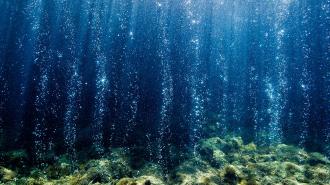The doctors are in, and they are giving the Earth a CAT scan. A team of geoscientists has developed a way to scan the planet and build a 3D model of its interior — using devices called MERMAIDs.
Bruce Buffett, a geophysicist at UC Berkeley, thinks we may know more about the interior of the sun than we do about the interior of our own planet. Still missing is knowledge about temperature, density, shape, and composition. The Earth’s interior may be the last wild frontier. But not for long.
Researchers, led by Princeton geoscientist Frederik J. Simons, plan to launch a fleet of 50 underwater drones, called MERMAIDs. The devices carry technology to scan the planet and create a snapshot of Earth’s internal dynamics, which can be used to build models of the past and make predictions about the future. For the reconnaissance mission, they will focus on measuring giant plumes of hot rock, 435 miles below the South Pacific Ocean.
“There are still great discoveries to be made right below our feet, and it actually may matter for our environment,” Buffett says. “There is this vast unknown, and I think on geological timescales that vast unknown contributes a lot. Things like (MERMAIDs) are moving us forward in that front.”
MERMAIDs (an acronym for “Mobile Earthquake Recording in Marine Areas by Independent Divers”) aren’t part human or part fish. They are underwater drones equipped with seismometers, hydrophones, and two-way satellite communication. They can dive to a depth of 3000 meters (1.86 miles) to collect data on Earth’s interior, then surface to send the data via satellite to a ground station. They can continue data collection without a scientist stepping in for as much as five years.
The team has already launched a fleet of MERMAIDs to collect data near the Galapagos Islands, and they are currently working on the next generation that they plan to launch deeper in the Pacific. Simons hopes that someday the devices will be deployed globally.
An array of land-based recording stations positioned around the globe are already doing this type of scanning. They listen for earthquakes on the other side of the planet. For example, if an earthquake in Japan were recorded at the UC Berkley station, which is buried deep in a hill on the campus, the record would provide information about the Earth’s interior between Japan and Berkley. Much like a medical CAT scan, which takes a cross-sectional picture of the human body to diagnose tumor locations or blood clots, the tomography scans, can be used to make a 3D image of the Earth’s interior. But two-thirds of the Earth is covered in ocean, leaving enough blind spots to keep researchers in the dark about the inner workings of the planet.
Even though there has been some effort to anchor devices to the seafloor, the oceans are by-and-large devoid of observation stations. Simons calls those that do exist the “Rolls Royce of data collection,” because they are expensive, robust, and capable. But, to him, the MERMAIDs. “are the Uber of seismology.” In other words, they get the job done at a fraction of the cost.
Simons says the new fleet of MERMAIDs will illuminate unknown parts of the planet, obscured to us because of the lack of seismic recording stations. The large, costly, ground-anchored sensors serve a similar data-collection function but lack the flexibility and resilience of the MERMAIDs. Once anchored to the seafloor, researchers cross their fingers and wait for years before retrieving the instrument, hoping the data is there. The unmanned drones, however, are lightweight and low cost. They drift thousands of meters deep and surface frequently to transmit useful earthquake data.
“There are still great discoveries to be made right below our feet, and it actually may matter for our environment.”
Bruce Buffett, Geophysicist at UC Berkeley
The project has been a 35-year-long passion for Simons, who says the data can be used by researchers to answer questions about the inner workings of the Earth’s mantle, the layer between the thin crust and the deep core at the center of the Earth. His focus is on the volcanic islands of French Polynesia. The mantle below, which is comprised of rock, contains mysteries that Simons wants to solve: Are there hot spots? Will they rise to the surface? How will an upwelling change surface features?
Simons says that listening for earthquakes in the ocean should become mainstream. But he has even higher goals for future generations of the MERMAID.
“There is much to measure in the ocean,” he says, calling for meteorologists, oceanographers, and biologists to unite. “A fleet of devices, like drones, that people can talk to, roaming around the oceans, with multiple instruments on them, not just seismometers… that needs to be a part of the future.”





